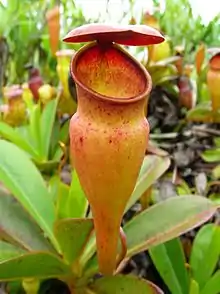Nepenthes pervillei
Nepenthes pervillei (/nɪˈpɛnθiːz pɜːrˈvɪliaɪ/; after Auguste Pervillé, French plant collector) is the only pitcher plant found in the Seychelles, where it is endemic to the islands of Mahé and Silhouette. It grows in rocky areas near granitic mountain summits,[1] its roots reaching deep into rock fissures. The species has an altitudinal range of 350–750 m above sea level.[3] Like all members of the genus, N. pervillei is dioecious, having separate male and female plants.
| Nepenthes pervillei | |
|---|---|
 | |
| An upper pitcher of Nepenthes pervillei | |
| Scientific classification | |
| Kingdom: | Plantae |
| Clade: | Tracheophytes |
| Clade: | Angiosperms |
| Clade: | Eudicots |
| Order: | Caryophyllales |
| Family: | Nepenthaceae |
| Genus: | Nepenthes |
| Species: | N. pervillei |
| Binomial name | |
| Nepenthes pervillei | |
| Synonyms | |
| |
The mite Creutzeria seychellensis has been found in the pitchers of N. pervillei.[4][5]
Taxonomy
The species was originally described as Nepenthes pervillei in 1852, but was later placed in the monotypic genus Anurosperma as Anurosperma pervillei, based on the morphology of its seeds, which differ from the closely allied N. madagascariensis (and the other members of Nepenthes) in that they lack the 'tails' characteristic of the rest of the genus. However, the more recent taxonomic database of Jan Schlauer subsumes Anurosperma back into Nepenthes.[6]
Long considered one of the more "primitive" species of Nepenthes,[7] recent molecular phylogenies have consistently placed N. pervillei in a basal position within the genus.[8][9][10][11][12]
Gallery
 Offshoots bearing mature pitchers
Offshoots bearing mature pitchers Inflorescence
Inflorescence
References
- Clarke, C.M. (2018). "Nepenthes pervillei". IUCN Red List of Threatened Species. 2018: e.T39687A143963252. Retrieved 30 June 2020.
- (in Latin) Blume, C.L. 1852. Ord. Nepenthaceae. In: Museum Botanicum Lugduno-Batavum, sive stirpium exoticarum novarum vel minus cognitarum ex vivis aut siccis brevis expositio. Tom. II. Nr. 1. E.J. Brill, Lugduni-Batavorum. pp. 5–10.
- McPherson, S.R. 2009. Pitcher Plants of the Old World. 2 volumes. Redfern Natural History Productions, Poole.
- Nesbitt, H.H.J. 1979. A new anoetid (Acari) of the genus Creutzeria from the Seychelles. Canadian Entomologist 111(11): 1201–1205.
- Fashing, N.J. 2002. "Nepenthacarus, a new genus of Histiostomatidae (Acari: Astigmata) inhabiting the pitchers of Nepenthes mirabilis (Lour.) Druce in Far North Queensland, Australia" (PDF). (1.64 MiB) Australian Journal of Entomology 41(1): 7–17. doi:10.1046/j.1440-6055.2002.00263.x
- Carnivorous Plant Database: Nepenthes pervillei
- Macfarlane, J.M. 1927. The Philippine species of Nepenthes. The Philippine Journal of Science 33(2): 127–140.
- Meimberg, H., P. Dittrich, G. Bringmann, J. Schlauer & G. Heubl 2000. Molecular phylogeny of Caryophyllidae s.l. based on matK sequences with special emphasis on carnivorous taxa. Plant Biology 2(2): 218–228. doi:10.1055/s-2000-9460
- Meimberg, H., A. Wistuba, P. Dittrich & G. Heubl 2001. Molecular phylogeny of Nepenthaceae based on cladistic analysis of plastid trnK intron sequence data. Plant Biology 3(2): 164–175. doi:10.1055/s-2001-12897
- (in German) Meimberg, H. 2002. "Molekular-systematische Untersuchungen an den Familien Nepenthaceae und Ancistrocladaceae sowie verwandter Taxa aus der Unterklasse Caryophyllidae s. l." (PDF). Ph.D. thesis, Ludwig Maximilian University of Munich, Munich.
- Meimberg, H. & G. Heubl 2006. Introduction of a nuclear marker for phylogenetic analysis of Nepenthaceae. Plant Biology 8(6): 831–840. doi:10.1055/s-2006-924676
- Meimberg, H., S. Thalhammer, A. Brachmann & G. Heubl 2006. Comparative analysis of a translocated copy of the trnK intron in carnivorous family Nepenthaceae. Molecular Phylogenetics and Evolution 39(2): 478–490. doi:10.1016/j.ympev.2005.11.023
Further reading
- Bauer, U., C.J. Clemente, T. Renner & W. Federle 2012. Form follows function: morphological diversification and alternative trapping strategies in carnivorous Nepenthes pitcher plants. Journal of Evolutionary Biology 25(1): 90–102. doi:10.1111/j.1420-9101.2011.02406.x
- (in French) Blondeau, G. 2001. Nepenthes Pervillei. In: Les Plantes Carnivores. De Vecchi, Paris. pp. 71–72.
- Fashing, N.J. 2010. "Two novel adaptations for dispersal in the mite family Histiostomatidae (Astigmata)" (PDF). In: M.W. Sabelis & J. Bruin (eds.) Trends in Acarology: Proceedings of the 12th International Congress. Springer Science, Dordrecht. pp. 81–84. doi:10.1007/978-90-481-9837-5
- Hartmeyer, S. 1993. "Nepenthes pervillei: travel report to accompany the new CP-video" (PDF). Carnivorous Plant Newsletter 22(3): 65–70.
- Jean, S.M. 2015. Less than 1,000 meat-eating plants found on Seychelles, report says. Seychelles News Agency, 27 December 2015.
- Kitching, R.L. 2000. Food Webs and Container Habitats: The natural history and ecology of phytotelmata. Cambridge University Press, Cambridge.
- Kitching, R.L. & C.J. Schofield 1986. Every pitcher tells a story. New Scientist 109(1492): 48–50.
- Malcomber, S.T. 1989. A survey of the Nepenthes pervillei communities in the Seychelles September 1989. [Sine nomine, sine loco.]
- (in Indonesian) Mansur, M. 2001. "Koleksi Nepenthes di Herbarium Bogoriense: prospeknya sebagai tanaman hias" (PDF). Archived from the original (PDF) on 2012-03-19. In: Prosiding Seminar Hari Cinta Puspa dan Satwa Nasional. Lembaga Ilmu Pengetahuan Indonesia, Bogor. pp. 244–253.
- Redwood, G.N. & J.C. Bowling 1990. Micropropagation of Nepenthes species. Botanic Gardens Micropropagation News 1(2): 19–20.
- (in German) Schmid-Hollinger, R. N.d. Nepenthes pervillei: Blütenbau. bio-schmidhol.ch.
- (in German) Schmid-Hollinger, R. N.d. Nepenthaceae: Axile oder parietale Placentation? bio-schmidhol.ch.
- (in German) Schmid-Hollinger, R. N.d. Kannendeckel (lid). bio-schmidhol.ch.
- Nepenthes pervillei and the Seychelles Odyssey by Colin Clayton of Triffid Park. Triffid Park.
| Wikimedia Commons has media related to Nepenthes pervillei. |

